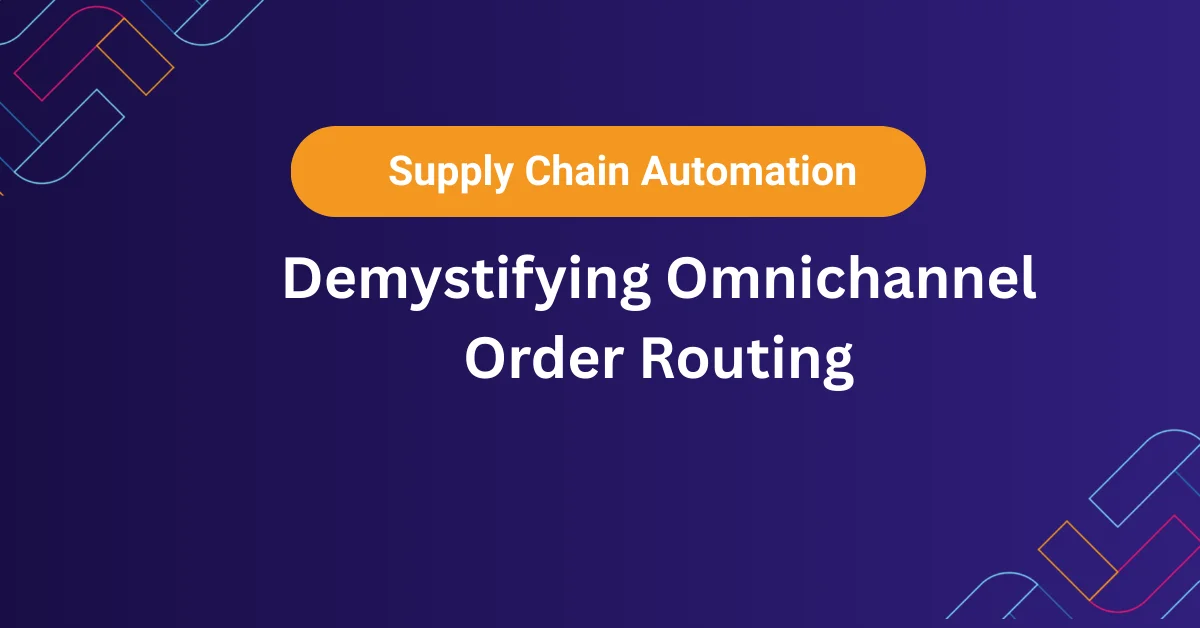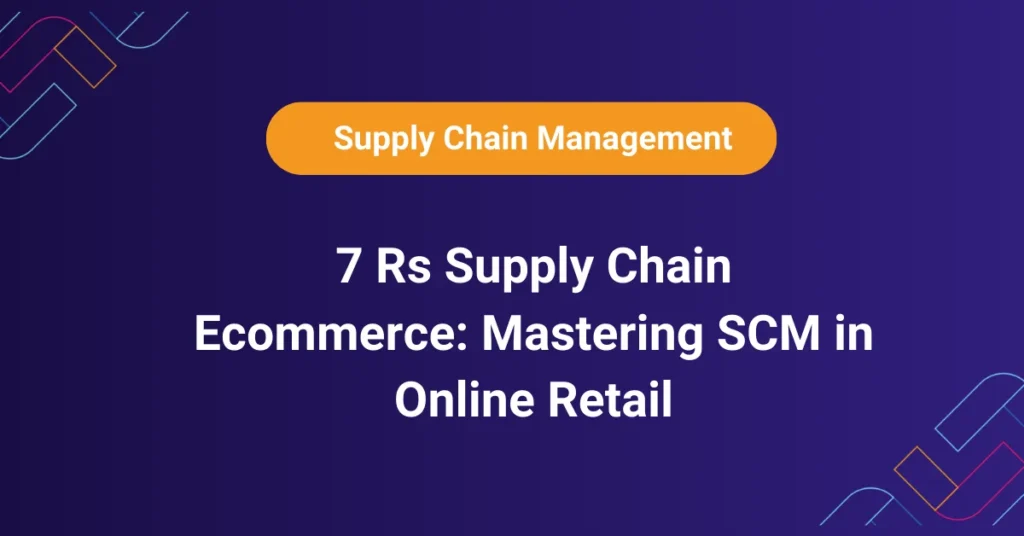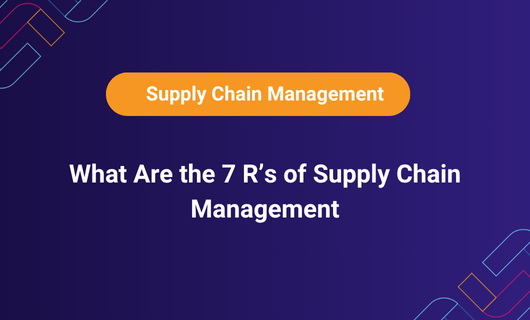Are you juggling fulfillment across warehouses, stores, and Amazon FBA, only to watch margins shrink and delivery promises break? Sky-high FBA fees, 3PLs that can’t match Prime speed, and the constant fear of overselling are crushing profitability. Mastering omnichannel order routing is your escape hatch. What if every order automatically chose its most profitable path to your customer? And what would flawless, automated fulfillment do for your brand’s reputation and your bottom line?
The Strategic Framework for Unbeatable Fulfillment
Juggling fulfillment sources manually is a high-cost, high-risk strategy that stifles growth at your scale. This guide provides the strategic framework to move from chaotic reaction to automated command through supply chain automation 2025 principles. We will deconstruct the exact blueprint for building a powerful omnichannel order routing system—your 24/7 logistics commander. You will learn how to establish inventory clarity, layer intelligent decision rules, and continuously optimize to ensure every order automatically selects the optimal path, transforming your fulfillment operation from a cost center into a measurable competitive advantage that protects margins and delights customers.
Demystifying Omnichannel Order Routing
So, what exactly is omnichannel order routing? In practice, it’s the intelligent, software-driven process that automatically selects the best location—be it an Amazon fulfillment center, a third-party logistics partner (3PL), a retail store, or a dropshipper—to complete a customer’s order. Its core mission is triple-fold: minimize shipping expense, guarantee delivery speed, and protect against the inventory missteps that anger customers. By integrating abc xyz segmentation, brands can further refine these decisions, ensuring orders are routed based not only on cost and speed but also on customer profile and demand patterns.
What data fuels an intelligent routing system?
An advanced Order Management System (OMS) acts as the central brain, processing live data from every corner of your operation: real-time stock levels from all warehouses and POS systems, constantly updated carrier shipping rates and transit maps, and precise customer delivery addresses.

The Non-Negotiable Foundation
Centralized Stock Pool:
Use an OMS that merges live counts from Amazon FBA, 3PLs, your warehouse (via WMS), and store POS systems so all channels pull from the same data.
Real-Time Sync:
Update instantly with every sale, return, or receipt. Delays cause overselling and unhappy customers.
Safety Stock Buffers:
Hold back a small reserve at each location. Mark it as unavailable to prevent stockouts from data lags.
How do I avoid overselling with multiple nodes?
Use a central OMS that syncs inventory in real time across all channels and locations. Add safety stock at each site to absorb data latency and avoid customer issues.
Architecting Your Decision Engine: The Rule Hierarchy
The true power of a sophisticated omnichannel order routing system lies in its use of layered, hierarchical logic. Think of it not as a single rule, but as a cascading decision-making funnel designed to emulate the choices of your most skilled logistics manager—but at scale and in milliseconds. Rules are evaluated in a strict, pre-defined sequence; the system processes each rule like a filter, and the moment a node meets a qualifying condition, the order is assigned. This sequential analysis ensures that your most critical business objectives—like protecting your customer brand promise—always take precedence over secondary goals like marginal cost savings. This methodical approach is what transforms a simple inventory locator into a profit-protecting order routing intelligence engine.
To visualize this hierarchy, consider this typical rule sequence evaluated for every single order:
| Priority Level | Rule Type | Primary Goal | Example Action |
|---|---|---|---|
| 1 | Mandatory | Prevent failure | Disqualify nodes without the item in stock or that are marked inactive. |
| 2 | Strategic | Honor SLA | Filter for only nodes that can physically achieve the promised delivery date. |
| 3 | Optimization | Maximize Profit | From the qualifying nodes, select the one with the lowest total fulfillment cost. |
| 4 | Business-Specific | Achieve Goals | Apply final rules like liquidating old inventory or utilizing a specific 3PL. |
This structured cascade ensures that an order for a Prime customer, for example, will never be accidentally sent from a low-cost node that misses the 2-day deadline, protecting your seller rating and customer trust. By establishing this clear rules & priorities framework, you move from chaotic, reactive fulfillment to a predictable, automated, and optimized operation that consistently makes the best possible choice for each unique order.
Rule 1: Honor the Delivery Promise (SLA)
The customer’s paid-for shipping speed is your first and most important filter. The system’s initial task is to disqualify any node that cannot physically meet this deadline.
- Intelligent Geo-Speed Calculation: The router assesses the transit time from each fulfillment node to the customer’s doorstep. Any location that can’t deliver on time is immediately removed from consideration.
- Practical Example: A Denver customer orders with a 2-day guarantee. Your Ohio 3PL (3-day transit) is out. Your Nevada FBA hub (2-day transit) and your local Denver store (next-day) are in.
Rule 2: Optimize for the Lowest Fully Landed Cost
With only SLA-qualified nodes remaining, the router performs a cost analysis to identify the most profitable fulfillment option.
- The Total Cost Equation Includes:
- Local picking and packing fees (for 3PLs/stores)
- Real-time outbound shipping rates from that node’s zip code
- Cost of packaging materials
- FBA’s Premium Fees: While blazing fast, FBA’s fulfillment and storage costs often exceed those of 3PLs. This rule frequently selects a 3PL for cost-sensitive, non-Prime orders.
- Special handling requirements (kitting, gift wrap)
How do I prioritize between FBA and 3PL?
The rule isn’t about manual choice—it’s about encoding logic. For Prime-eligible orders where speed is the absolute priority, FBA is king. For standard shipping orders where protecting margin is critical, the system should prioritize a lower-cost 3PL or a strategically located store.
Rule 3: Execute on Strategic Business Goals
This final layer allows you to incorporate unique operational objectives into the automated workflow.
- Manage Node Capacity: Automatically route orders away from a 3PL that reports being at full capacity to prevent processing delays.
- Liquidate Aging Stock: Prioritize shipping from locations that contain older or seasonal inventory to improve cash flow and reduce holding costs.
- Minimize Split Ships: Favor nodes that contain the entire order to enhance the customer experience and control shipping costs.
Leveraging Strategic Split-Shipments
While generally a last resort, intelligently dividing an order across locations is a powerful tool to prevent cancellations and meet SLAs.
What is split-shipment logic?
Split-shipment logic is a sophisticated rule that allows a single customer order to be partitioned and sent from multiple inventory locations. It activates when no one location has sufficient stock to meet the delivery promise on its own.
Guiding Principles for Splits:
- A Necessary Evil: Splitting should be a last resort, as it increases costs and complicates tracking.
- Maximize Cartons: The algorithm should aim to ship the fewest packages possible. For a 3-item order, it should source 2 items from Location A and 1 from B, not 1 from A, 1 from B, and 1 from C.
- Proactive Communication: The customer must be notified at checkout that their order may arrive in multiple packages.
Calculating the Ship-From-Store ROI
When is ship-from-store worth it?
Turning a store into a mini-fulfillment center is profitable when its geographic proximity to the customer enables cheaper, faster shipping than a distant warehouse, and the cost of store staff’s time to pick, pack, and ship is less than the alternative fulfillment fees.
ROI Breakdown:
- Scenario: Shipping a $100, 1 lb sweater from a Boston store to a NYC customer.
- Store Cost: $3 (15 mins of labor) + $8 (USPS Priority) = $11
- West Coast 3PL Cost: $3 (pick/pack) + $12 (ground shipping) = $15
- FBA Cost: ~$10.05 (standard-sized fulfillment fee)
- Analysis: Here, ship-from-store saves $4 vs. the 3PL. However, during peak store hours, the labor cost must be carefully monitored.
The Cycle of Measurement and Refinement
Your omnichannel order routing strategy is a living system. Continuous monitoring and adjustment are key to maximizing its ROI as carrier networks, costs, and your business evolve—especially when considering how to streamline your global product sourcing to align with changing fulfillment demands.Critical KPIs to Monitor:
-
- Average Fulfillment Cost per Order: The primary measure of cost-saving success.
- Mean Delivery Time: Track the impact on customer delivery speed.
- On-Time Shipping Rate: The ultimate measure of SLA adherence.
- Optimal Node Utilization Rate: How often did the system make the perfect choice?
- Inventory Accuracy & Oversell Rate: This must trend as close to zero as possible.
How do I test routing rules?
Employ a low-risk, phased rollout. First, run new rules in a “shadow mode” or simulation, comparing the system’s automated decisions against your historical manual choices. Then, pilot the rules on a small segment of orders (e.g., 5%) or a single sales channel before full deployment.
The Compound Benefits: Beyond Shipping Savings
Perfecting your omnichannel order routing delivers strategic advantages that ripple across your entire business.
- Superior Cash Flow: By strategically depleting inventory from specific nodes, you reduce overall carrying costs and free up working capital for growth initiatives.
- Dramatically Fewer Stockouts: Treating your entire network as one fluid pool means you almost never have to mark an item “out of stock” simply because it’s sitting in the wrong warehouse.
- Significant Labor Efficiency: Automating this complex workflow reclaims dozens of hours per week for your ops team, allowing them to focus on strategic analysis instead of manual order assignment.
How to decide speed vs cost?
You don’t—your system does. The rules are predefined: a Prime-order tag automatically prioritizes speed, while a standard shipping order triggers a cost-optimization rule. The router impartially executes the strategy you’ve encoded.
Frequently Asked Questions
What is the main goal of omnichannel order routing?
The primary goal is to use automation to select the most profitable and efficient fulfillment location for every order, balancing delivery speed promises with minimal cost, while completely eliminating the risk of overselling inventory.
Can I use omnichannel routing without an OMS?
It is highly impractical and risky at scale. An Order Management System (OMS) is essential as it provides the real-time, centralized inventory data and automated logic required for accurate, profitable, and safe routing decisions.
How does routing help with inventory management?
It transforms your disjointed inventory locations into a single, agile network. You can strategically direct sales to reduce overstock in specific warehouses, improve overall inventory turnover, and significantly increase the availability of best-selling products.
Is this strategy only for large enterprises?
Not at all. Any brand selling through multiple channels (e.g., their own Shopify store and Amazon) and storing inventory in more than one location can implement basic routing rules to immediately reduce costs, prevent oversells, and improve customer satisfaction.
Transform Your Fulfillment from a Cost Center to a Competitive Advantage
You scaled to eight or nine figures by mastering product, marketing, and customer experience. Don’t let manual, chaotic fulfillment be the anchor that holds you back. Implementing a sophisticated omnichannel order routing system is the final piece of the puzzle—automating your logistics for unparalleled efficiency and profit. Brankit’s supply chain platform is engineered for this exact purpose. We provide the unified OMS, intelligent automation, and expert guidance to design and deploy a routing strategy that is uniquely tailored to your business goals.
Ready to ensure every order automatically finds its most profitable path to your customer? Talk to our supply chain experts to see a customized routing simulation for your brand. Schedule a Call with a Brankit Expert.





